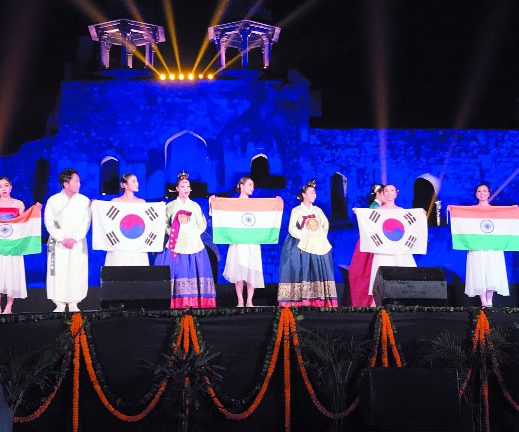The first day of the Delhi International Arts Festival showed a number of dances presented by artists from different nations.
The world of art knows no prejudice or boundaries. As the best artists from across the globe congregated at the opening ceremony of the 12th edition of Delhi International Arts Festival (DIAF) at Purana Qila, it witnessed performances from Korea, China and Sri Lanka hitherto unseen in India.
Aruna Vasudeva, who is also known as the mother of Asian cinema and one of the directors of DIAF said, “The Indian art and cultural industry is evolving and spreading at a very fast pace reaching to a global audience. One can see a lot of Indian performances across the world and numerous foreigners learning Indian art forms today. I find all of this very exciting. People get to see such disparate art forms under one umbrella.”
She believes that this is just the beginning of the biggest and largest cultural equity. “I must say, this opening ceremony of DIAF is absolutely surprising. The fact that there are four performances — from India, Korea, China and Sri Lanka — is a visual feast. Four entirely different nations performing together, and that too in India. Could anything be more breathtaking? DIAF has a lot to offer to art connoisseurs in Delhi,” she added.
The opening performance at the festival presented Indian tabla player, Akram Khan, which Vasudeva saw as “an exciting rhythmic ensemble.” There was yet another first-of-its-kind element that grabbed eyeballs and applause — Korean dance performance.
After Korea’s division into North and South segments, their dance and art forms also got diversified. Today, both the dance styles have their respective characteristics, which they collaborated to perform together for the first time sharing a single stage — unlocking a historical milestone at the ceremony. It represented the beginning of diplomatic ties between the two Korean countries, creating a beautiful symphony and synchronisation for viewers. The act’s depiction of the confluence of cultures undoubtedly left an impact among the audience.
Director of the Korean Cultural Centre India, Kim Kum Pyoung said, “It’s the first time two borders are collaborating with each other for an international arts fiesta. This inter-Korean peace process has got international interest and highlights this year. We would like to lead the interests to South and North Korea’s’ cultures and arts with similarities and distinctive characteristics.”
The Korean group prepared over 12 performances which included their traditional songs and dances. The first performance was a tri-coloured fan dance that used a two-metre-long colourful cloth-like fan, creating wave-like patterns and a domino effect across the stage. The splendid and dynamic sight left the audience amazed and the theatre was filled with claps.
It was followed by Teapyung, a unique form of Korean folk dance that was performed for the peaceful reign (Taepyeong) of the king and the nation. Then there was Pansori, a representative style of music where two people were involved — gosu, who leads the rhythm and sets the melody and sorykkun, the singer who shares descriptive stories on various facets of life. They had a musical conversation with each other by weaving the two aspects into one.
Another performance included Jeanggang dance, representing North Korea. Performers wore steel bracelets and danced to the rhythm of merry tunes.
The performers also presented Chukwon dance. This extravagant style is performed during happy occasions, and during the visit of the foreign envoys.
Apart from Korean performances, the opening ceremony also witnessed the mesmerising performances like the traditional folk dance by dancers from Sri Lanka. The Chinese Drum Opera from Shanghai made creative use of folk as a cultural strategy for national integration.
This was just the beginning. From the most traditional to the most contemporary expressions of art forms, DIAF offers all, while maintaining the uniqueness and diversity of India’s artistic and cultural traditions.
Writer: Ayushi Sharma
Courtesy: The Pioneer








 OpinionExpress.In
OpinionExpress.In















Comments (0)